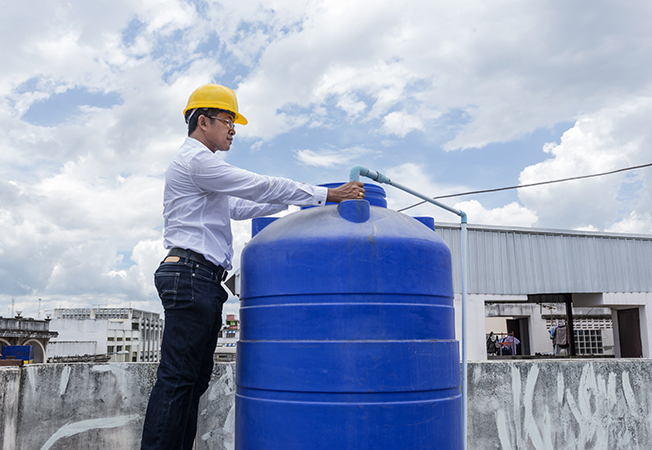Waterproofing solutions
Plastic Tank Leakage
Plastic water tank leakage solution
The water tank is an ultimate device used across many buildings to store portable water. Water tanks are usually made of materials like cement or plastic. However, these materials erode and get cracks, and services in the long run. Then arises the problem of cement or plastic water tank leakage, which can be complex to handle. Needless to say, if you do not find an effective solution for plastic water tank leakage, the problem can worsen. The leaking water can seep through the internal walls, and ceilings, and penetrate the roof, causing major structural damage to your home. Hence finding an efficient cement or plastic water tank leakage solution is important. Of course, using a plastic water tank cover does not work as a foolproof solution to the leakage problem.
Hence in this blog, we have listed the ultimate plastic water tank leakage treatment. So keep reading further for more insights!

TABLE OF CONTENTS
How to Stop Repair Leakage from a Plastic Water Tank?
Step by Step Process to fix a leak in a water tank
What are the precautions to consider to stop plastic tank leakage in future?
Different Methods to Stop Plastic Tank Leakage
How to Stop Water Leakage from a Plastic Water Tank?
Before we provide you with the answer to how to repair plastic water tank leakage, let us understand the root cause of water leakage from the tank.
One of the possible reasons could be the age of the water tank itself. There could also be a possibility of water leakage from inside the tank. In any case, once you know the cause of the leakage, it will help you with the plastic water storage tank leak repair
Remember that regular maintenance of the water tanks is required to ensure they are healthy. The maintenance not only helps to ensure proper hygiene but also keeps these water-storing units long-lasting. It is advisable to use a plastic water tank cover to ensure it is protected. Now, let us find out how to repair the plastic water tank leakage
Step by Step Process to fix a leak in a water tank
Fixing a leak in a plastic water tank, such as a PVC or polyethene tank, can be a simple DIY task if handled carefully. Here’s a step-by-step process -
Step 1: Locate and Mark the Leak
Empty the tank and inspect it thoroughly to find the leak location. Wipe the area around the leak to remove any dirt, algae, or debris. Once you find the leak, mark the spot with a waterproof marker.
Step 2: Prepare the Tank Surface
Dry the area that is causing the leak, and sand the surface a bit if necessary, if needed.
Step 3: Choose an Appropriate Repair Material
According to the leak select a proper plastic water tank leakage repair material there are various such as plastic water tank leakage solution and PVC water tank leakage solutions.
Step 4: Apply the Repair Material
Read the guidelines given on the Repair Material chosen by you, and apply it to the leak following the same. Make sure the leak is covered properly and let it dry based on the guidelines given.
Step 5: Test the Repair
Once it’s dry, fill the tank and check for any leaks. If a leak is visible, repeat the process.
Get the best Waterproofing with Asian Paints Damp Proof
What are the precautions to consider to stop plastic tank leakage in future?
To prevent future leaks in plastic water tanks, regularly inspect for damage, avoid overfilling, and place tanks in shaded areas to reduce sun exposure. Ensure a stable, even foundation, and avoid unnecessary drilling. Using pressure release valves for larger tanks and investing in high-quality, durable tanks also minimizes leakage risks.
Different Methods to Stop Plastic Tank Leakage
Heating method to stop plastic tank leakage
This method is adopted when the crack’s size is considerably small and at the top of the water tank. This solution for plastic water tank leakage utilizes a soldering iron to fix the crack with tank waterproofing. Professional preheat the soldering iron and touch it on the top of the crack to let the crack melt, join, and dry thoroughly.
For larger cracks, professionals waterproofing contractors drill holes alongside the cracks and then proceed with heating the area around the crack using a heat gun and making a v-groove along the crack with a drill machine’s help. This plastic tank leakage solution supports fixing the backside of the tank as well
Fiberglass to stop plastic tank leakage
In this method, the area where the crack is present needs to be thoroughly cleaned, before applying the fiberglass. Professionals then start applying a single layer of fibreglass on the crack and then mould it in the desired shape. In this process, experts use resin: a very sticky liquid, to glue fiberglass around the crack.
Epoxy/ Putty to stop plastic tank leakage
Yet another method to stop plastic tank leakage is by applying epoxy or putty to seal cracks of the water tanks. In this method, professionals use two compounds to prepare a solution. Once the solution is prepared, experts apply the putty and mould it around the crack, and let it dry completely as per the prescribed time. It is one of the most popular, and highly effective methods to prevent water tank leakage.
Pro tip - Asian Paints SmartCare FabSeal is a fast-curing epoxy compound that can be used for fixing water tank leaks, plugging holes, and repairing cracks. It does not shrink post-application, thus ensuring maximum sealing or repair.
How can Asian Paints help you with water leakage solutions?
Are you looking to amp up the interiors of your home? Well, Asian Paints Beautiful Home Services is to your rescue. We ensure not only the cosmetic appearance but also the structural longevity of your dream home. With our design experts' personal decor recommendations coupled with our waterproofing solutions, you are all set to rebuild/build the home of your dreams!
Book your appointment with our experts today!

FAQs
How can I identify the exact location of a leak in my water tank?
To locate a leak, empty the tank and inspect for visible cracks. Alternatively, fill it halfway and look for water droplets or damp spots around suspected areas. Depending on the leak use a proper plastic water tank leakage solution.
What materials do I need to repair a leak in a plastic water tank?
For effective plastic water tank leakage repair, gather epoxy putty, silicone sealant, or a plastic welding kit. These materials create durable seals on plastic surfaces, making them a sufficient plastic water tank leakage solution.
Are there specific sealants recommended for plastic water tanks?
Silicone-based or waterproof polyurethane sealants work well for plastic tanks. Make sure you use a non-toxic, waterproof, and plastic water tank leakage solution specifically designed to bond.
How do I prepare the surface of the tank before applying a repair solution?
Clean and dry the area around the leak, then lightly sand it to create a rough texture. This improves the adhesive bond and makes sure plastic tank leakage repair material sticks securely to the surface.
Is it necessary to empty the water tank before repairing a leak?
Yes, it’s necessary to empty the water tank for the plastic tank leakage repair.
LIKE THIS ARTICLE
Give us a thumbs up!








